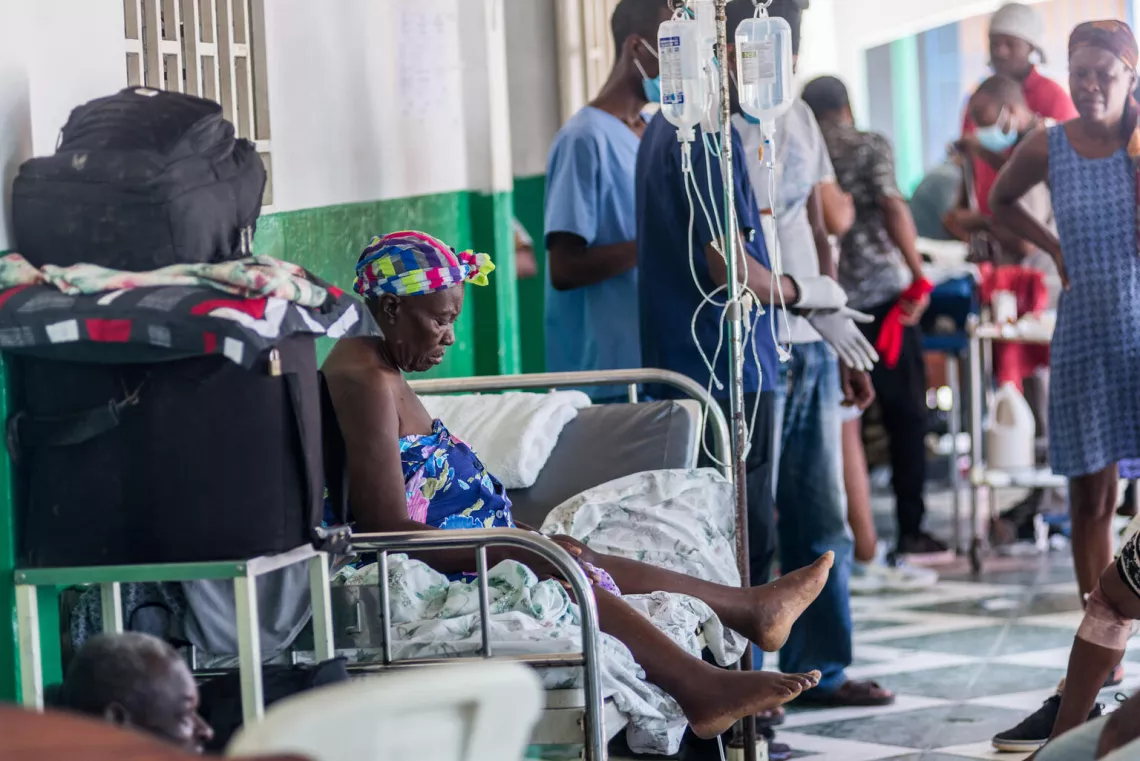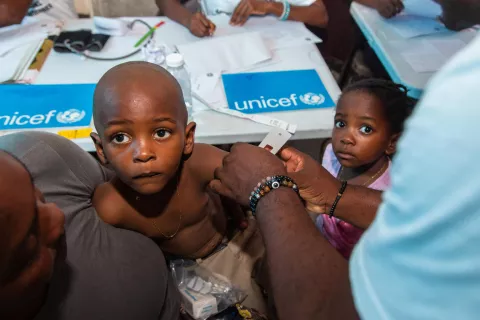With their feet underwater, homeless, and malnourished
After the earthquake, Haitian children face again a state of shock.

- Available in:
- Español
- English
A magnitude 7.2 earthquake caused the death of at least 2,207 people, injured 12,268, and impacted nearly 1.2 million -- including 540,000 children -- destroying homes, hospitals, schools, and bridges in a country already stricken by political instability, violence, and the COVID-19 pandemic.
Les Cayes, Haiti - When the earth shook, Gerline Vilsaint was inside her house with her seven-month-old baby and younger sister. “The concrete slabs fell on them. When I arrived, I called out for them and they answered. Then I asked my neighbors for help. First, they pulled out the baby, but he was already dead,” Gerline’s husband, Jackson Telamo, recalls about the aftermath of the magnitude 7.2 earthquake that affected 1.2 million people -- including 540,000 children -- and caused a death toll over 2,000 in southwestern Haiti on August 14th.
The woman emerged from the rubble paralyzed. Today, unable to move her limbs, she lies on a tarp in a courtyard of Immaculate Conception Hospital (HIC) in Les Cayes, one of the areas hardest hit by the earthquake. Telamo is very worried. He doesn’t want to tell his wife that their baby is dead. “The doctors have told me that my wife’s case is too much for them, that she’d have to go to Port-au-Prince. They just gave her saline solution and prescribed painkillers. If I were to tell her that our son is gone, she would be very upset," he says despondently.

According to the latest reports, at least 2,189 people died and 12,000 were injured in the departments of Grand’Anse, Sur, and Nippes -- the epicenter of the earthquake in Haiti -- although the tally of victims and damages is growing quickly with each passing day.
More than half a million children and teenagers were affected by the earthquake, according to UNICEF figures. And their situation is critical, especially considering that the humanitarian situation was already precarious before the recent storm, with 4.4 million people in need of assistance, including 2.2 million children.

Essential facilities which children and their families depend on have disappeared, including houses, schools, and hospitals. Some have lost their families and others were separated in the middle of the chaos. In the streets, backhoes clear rubble and people with baskets rummage through what remains of their destroyed homes in search of clothing and food. Children and mothers gather outdoors under tarps in a makeshift camp under the rain, with no certainty of when they’ll have a roof over their heads again.
The earthquake left 52,953 homes completely destroyed and 77,006 badly damaged, according to UNICEF estimates.
The calamity also reached health centers, which saw massive arrivals of injured patients while cracks started appearing in the buildings: 25 facilities were partially damaged and five were completely destroyed in the three departments most affected by the earthquake.


Amid the wreckage, outside, a girl covers herself with an umbrella while a nurse gives her saline solution and the girl’s father takes her hand. The injured pile up in hospital beds in the middle of the street, covered by pieces of fabric tied to trees and building columns. A woman is carried on a wooden board to be seen by a doctor in a makeshift tent acting as a medical center.
“We don’t know exactly how many patients were admitted due to the earthquake,” says Dr. Pierre Jame, a surgeon at HIC, one of the three main hospitals in the area along with OFATMA Hospital and HSA Jeremie. “We’ve admitted many children and women,” adds Jean Saint Messeroux, a surgeon and director of OFATMA Hospital, who explains that many have reached the hospital with amputated limbs and several have had to settle in the center's open-air arcades.

The earthquake was followed by the landfall of Tropical Storm Grace, further complicating rescue work among the wreckage and the arrival of aid due to flooding and mudslides. All of this occurs in a country already facing political instability, escalating violence, and the COVID-19 pandemic.
In this context, the United Nations Fund for Children (UNICEF) has been on the ground since the first moment, distributing essential supplies such as drinking water, personal hygiene and sanitation material, and tarps to set up emergency shelters in the affected areas. UNICEF also handed out medicine and first-aid kits with gloves, painkillers, antibiotics, and syringes to treat 30,000 earthquake victims for at least three months.

For the children, support also included psychosocial assistance, blankets, clothing, recreational kits, therapeutic foods, and ready-to-eat nutritional supplements to prevent deterioration in nutritional health, in a country with alarming rates of malnutrition.
The store room in OFATMA Hospital was already bare when the supplies arrived, according to the hospital’s medical director.
“UNICEF was likely the first organization to arrive. We welcomed their assistance because we were facing shortages of gloves and other medical supplies. The second level of support the organization provided consisted of tents and tarps to help us protect our patients,” said Dr. Messeroux.
Outside the building, a 72-meter-long tent serves as a shelter from the rains for dozens of patients under observation. “We’ve treated 1,500 patients thanks to UNICEF’s support,” the surgeon adds.

Evelyne Dominique Chery, who leads the UNICEF team in Les Cayes, said that synergies with medical authorities and the rapid response from private suppliers allowed assistance to be delivered on time. “The materials were delivered the following morning,” she explained.
“You have to invest in the short, medium, and long term, whether that involves making improvements to the hospital building or helping us find prefabricated buildings where we can continue to treat our patients,” Messeroux adds.


According to UNICEF estimates, 15 million U.S. dollars are needed to respond to urgent needs. The funds would allow 385,000 people -- including 167,000 children under the age of five -- to receive medical attention over a period of eight weeks. The assistance covers programs in health, water, sanitation, child protection, education, social protection and communication, in addition to cash transfers to the most vulnerable.
But it’s still not enough. The tragedy comes eleven years after another magnitude 7.1 earthquake hit just southeast of Haiti’s capital, Port-au-Prince, killing more than 300,000 people and causing incalculable damages that are still felt today. This time, Haitians once again lost everything in the earthquake and are living -- literally -- with their feet under water.

Bruno Maes, UNICEF’s representative in Haiti, summarizes the need to obtain funds to address the desperate situation of children on the island: “The children of Haiti need solidarity and support. The parents and teachers that have lost everything need support. And we need resources to rebuild some schools, rehabilitate others, and equip every classroom with desks, teachers, and students with educational and pedagogic kits. Getting children and teenagers back to the classroom is perhaps the best way of ensuring that they, their families, and their communities can recover.”
KEY FIGURES
UNICEF estimates that US$15 million are required to address the most urgent needs.
- US$2,7 million in health to treat 385,000 people
- US$1 million for 167,118 children aged 0 and 59 months
- US$4 million for the water and sanitation needs of 200,000 people
- US$3 million for protection for 180,000 children
- US$3 million for education for 75,000 children
- US$1,2 million for social protection for 6,000 vulnerable families
- US$100.000 for communication programs that reach 1,000 children




